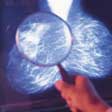 Defining
what digital can do "There's a lot of anxiety associated with recalling women," Lindfors said. "It's also an inconvenience because they have to take time off from work. In addition, there are more expenditures. If we reduce the number of call-backs, then certainly there will be an advantage. But we cannot sacrifice our sensitivity and accuracy in diagnosing breast cancer." Another potential advantage to digital, Lindfors said, is that images can be transmitted to other sites via computer link. So a radiologist in one community would be able to send an image he or she has questions about to an expert in some other location for review. In addition, digital mammography will help spawn other technological developments aimed at improving breast cancer detection. One program in the works that will be used with digital mammography is computer-assisted detection. The software program points out certain abnormalities in the breast that the radiologist should analyze by placing a mark on the areas or magnifying the view. One issue that might hold back rapid adoption of digital mammography is the cost. Some of the machines come with a price tag of up to $400,000, almost three times the amount for film-screen equipment. But this may be balanced by reducing recall rates. "If we can avoid some of the anxiety associated with recalling patients or with negative biopsies, that will be an advantage to both the women undergoing screening and to the health-care system because it will cost less," Lindfors said. UC Davis began accepting women into the study last fall. Women will receive both a digital and standard mammo-gram at the same time. The exams will be independently interpreted by two different radiologists. Women will be called back for further examination if something suspicious shows up on either mammo-gram. The participants will be followed for a year. UC Davis will enroll 2,500 women. To be eligible, women must be UC Davis patients. Other requirements are: They must be due for their annual screening exam, can't be pregnant, have breast lumps, nipple discharge or breast implants. Women who have had a lumpectomy for breast cancer are also ineligible.
Home |
Table of Contents |
To our Readers |
Building on Basics UC Davis Health System | © 2000, 2001, 2002 UC Regents. All rights reserved. |
Women enrolled in the study will have both a digital and standard mammogram taken. Each mammogram will be reviewed independently by two different radiologists. |

